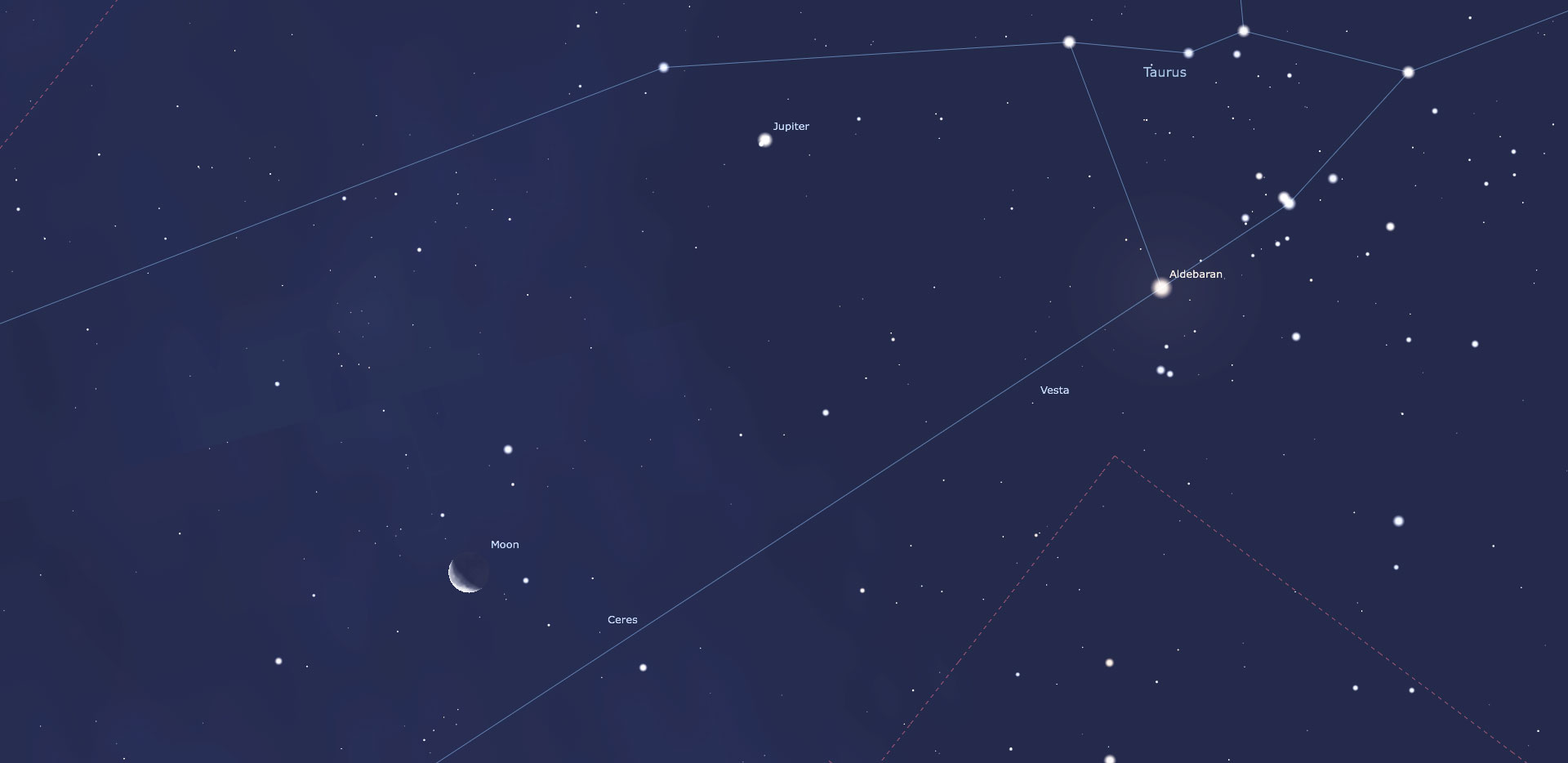
Asteroids, Meteors, & the Dog Days
August 2012 :
August begins with the heart of the Milky Way passing over due south just after darkness, and Mars is within 8° of Saturn. The two evening planets form an isosceles triangle with Spica that becomes nearly equilateral on the 8th of the Month. The three objects form a line on the 13th and 14th when Mars basses between them. Another nearly equilateral arrangement of the three objects is joined by the waxing crescent Moon on the 18th.
Venus and Jupiter continue to dominate the morning sky, with the Moon passing them between the 11th and the 14th. This is around the same time of the peak of the Perseids meteor shower. Also making a favorable appearance in the morning sky during mid-month is Mercury. which reaches greatest elongation (19° west) on the 16th.
Spot the first four asteroids during August
The first three minor planets to be discovered, 1 Ceres, 2 Pallas, and 3 Vesta can all be easily spotted in binoculars and small telescopes during August using our solar system’s more well-known members to guide the way. Asteroid 4 Juno is also visible, but in a “remote” region of sky devoid of solar system bodies as well as bright stars.
The asteroid Vesta, currently being orbited by the Dawn mission, passes just 11” north of Aldebaran on August 5 & 6. Vesta shines at magnitude 7.6, making it an easy binocular object. Aldebaran is a magnitude 1.5 spectral type K5III (orange giant) star that shines 500 times as luminous as the Sun at a distance of 65 light years.
On the morning of the 12th, the peak of the Perseids, the waning crescent Moon will guide you to Ceres, the largest of the main belt asteroids, and Dawn’s next destination on the 12th. Ceres is shining at magnitude 8.3.
You may want to try a third asteroid, Pallas, which lies within 4° of Uranus throughout the month. Uranus (magnitude 5.8) and Pallas (magnitude 8.9) are in an area of the sky devoid of relatively bright stars, posing a bit of a challenge to locate them. You’ll have best results by first locating Uranus and familiarizing yourself with the starfield surrounding it. Uranus crosses the meridian at 4:30 at the beginning of the month and 2:30 at the end, so this is a late evening/early morning adventure. As Pallas loops around the field just to the east of Uranus throughout the month, it will also brighten from magnitude 9.3 to 8.9. The waning gibbous Moon passes the pair on the 5th and 6th, which may make Pallas a bit more difficult to pick up in binoculars.
If you want to round out the list of the first 4 minor planets, challenge yourself by spotting 3 Juno, which was at opposition back on May 20 and still hovers near the border of Libra and Serpens and shines at about magnitude 10.7.
Sometime during mid-month, probably a few short days after the peak of the Perseids, you may notice that you can see a bright star low in the southeast in the morning dawn. If you notice how it lies in line with Orion’s belt, you will recognize this as Sirius, the brightest star besides the sun in our sky. Sirius is also known as the Dog Star, due to its position in the constellation Canis Major, the big dog. When the Dog Star first becomes visible in our morning sky, this begins the dog days of August. Now that you know that Sirius can be seen in the warm month of August beyond the symphonies of the crickets (we most often see it during the cold months when it is visible early in the evening sky), wouldn’t it be fun to challenge yourself to see how early in August you can spot it?
Neptune reaches opposition on August 24th, the same date in 1989 when it was visited by Voyager 2. That was also the date that I first observed the (then and now) most distant planet in our solar system. (In 1989, Pluto was still considered to be the ninth planet, but was actually slightly closer to the Sun than Neptune.)



